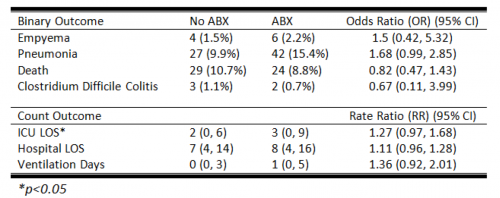Systemic air embolism (SAE) is an uncommonly encountered but potentially catastrophic complication that trauma professionals will probably see only once or twice in their career. In a couple of very old papers (30-35 years!), it was said to occur in 4 to 14% of patients with severe lung trauma. The pathognomonic finding is complete cardiovascular collapse shortly after intubation and positive pressure ventilation of a patient with significant chest trauma.
SAE can occur after major blunt or penetrating injury. Normally, pressure in the pulmonary arterial and venous branches of the lungs is higher than that of air in the bronchi. If lung parenchyma is torn by gunshot, stab, or blunt pulmonary laceration, then blood can leak into the smaller airways. Unless a major vessel is torn, the volume lost is not of much consequence. A small amount of hemoptysis may be present.
But if positive pressure is applied to the airways, air may be forced into those vascular structures. If the injury involves a pulmonary vein, the gas bubbles enter the left heart and and then the systemic circulation. Only a cc or two of air in the cerebral circulation or coronary arteries can cause a rapidly fatal condition.
How can a trauma professional suspect that a patient may be susceptible to SAE? Look for evidence of hemoptysis in patients with penetrating chest injury or severe blunt chest trauma. Unfortunately, this occurs in only a few patients and its absence is not helpful.
Always suspect SAE if your patient suffers circulatory collapse or arrest shortly after intubation and positive pressure ventilation. This is especially true in patients who were very stable up until that point. Ultrasound may be used to detect air bubbles in the left heart. Transesophageal echo is even better, but not readily available in the ED.
What can be done if your patient (nearly) arrests after intubation and you suspect SAE? The recommended treatment is single lung ventilation and thoracotomy on the injured side. The injured side is obvious in patients with unilateral penetrating injury, but much more difficult to determine in blunt trauma where either lung may be involved. A quick chest x-ray could be obtained, but may not localize the injured lung.
If the left lung is involved, push the endotracheal tube into the right mainstem bronchus to eliminate the abnormal pressure gradient in the injured lung. If the right lung in injured, a dual lumen endotracheal tube should be inserted for single-lung ventilation. Unfortunately, this requires fiberoptic tools and is not available in the field or most emergency departments.
If single-lung ventilation can be accomplished, this may buy some time to try to resuscitate your patient. A thoracotomy of the injured side can also be carried out to occlude the hilum of the lung in an attempt to stop any further embolism. Initial clamping should be carried out by hand, as using a crushing clamp commits the patient to an emergency pneumonectomy (if they survive beyond this point).
Overall survival is dismal. Old data suggests that more than 80% of blunt trauma victims with SAE die, as well as half of patients with penetrating injury. These numbers are even lower once the patient arrests. The key to survival is avoiding unnecessary intubation in patients with potential SAE, and moving to single-lung ventilation quickly in those who have developed it.



